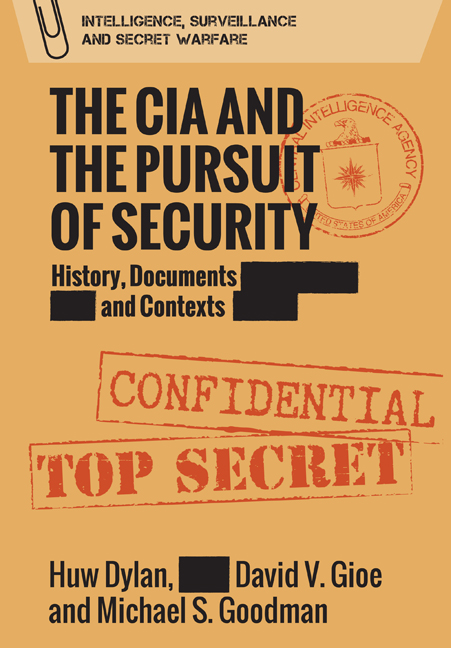Book contents
- Frontmatter
- Contents
- List of Documents
- Foreword
- Acknowledgements
- Introduction
- 1 Intelligence for an American Century: Creating the CIA
- 2 The Development of CIA Covert Action
- 3 A ‘Gangster Act’: The Berlin Tunnel
- 4 The CIA and the USSR: The Challenge of Understanding the Soviet Threat
- 5 Anglo-American Intelligence Liaison and the Outbreak of the Korean War
- 6 The CIA and the Bomber and Missile Gap
- 7 The CIA and Cuba: The Bay of Pigs and the Cuban Missile Crisis
- 8 The CIA in Vietnam
- 9 The CIA and Arms Control
- 10 The CIA’s Counter-Intelligence Conundrum: The Case of Yuri Nosenko
- 11 1975: The Year of the ‘Intelligence Wars’
- 12 Watching Khomeini
- 13 The CIA and the Soviet Invasion of Afghanistan
- 14 Martial Law in Poland
- 15 Able Archer and the NATO War Scare
- 16 The Soviet Leadership and Kremlinology in the 1980s
- 17 The CIA and the (First) Persian Gulf War
- 18 A Mole in Their Midst: The CIA and Aldrich Ames
- 19 ‘The System was Blinking Red’: The Peace Dividend and the Road to 9/11
- 20 Reckoning and Redemption: The 9/11 Commission, the Director of National Intelligence and the CIA at War
- 21 The ‘Slam Dunk’: The CIA and the Invasion of Iraq
- 22 The Terrorist Hunters Become Political Quarry: The CIA and Rendition, Detention and Interrogation
- 23 Innovation at the CIA: From Sputnik to Silicon Valley and Venona to Vault 7
- 24 Entering the Electoral Fray: The CIA and Russian Meddling in the 2016 Election
- 25 Flying Blind? The CIA and the Trump Administration
- Bibliography
- Index
10 - The CIA’s Counter-Intelligence Conundrum: The Case of Yuri Nosenko
Published online by Cambridge University Press: 24 September 2020
- Frontmatter
- Contents
- List of Documents
- Foreword
- Acknowledgements
- Introduction
- 1 Intelligence for an American Century: Creating the CIA
- 2 The Development of CIA Covert Action
- 3 A ‘Gangster Act’: The Berlin Tunnel
- 4 The CIA and the USSR: The Challenge of Understanding the Soviet Threat
- 5 Anglo-American Intelligence Liaison and the Outbreak of the Korean War
- 6 The CIA and the Bomber and Missile Gap
- 7 The CIA and Cuba: The Bay of Pigs and the Cuban Missile Crisis
- 8 The CIA in Vietnam
- 9 The CIA and Arms Control
- 10 The CIA’s Counter-Intelligence Conundrum: The Case of Yuri Nosenko
- 11 1975: The Year of the ‘Intelligence Wars’
- 12 Watching Khomeini
- 13 The CIA and the Soviet Invasion of Afghanistan
- 14 Martial Law in Poland
- 15 Able Archer and the NATO War Scare
- 16 The Soviet Leadership and Kremlinology in the 1980s
- 17 The CIA and the (First) Persian Gulf War
- 18 A Mole in Their Midst: The CIA and Aldrich Ames
- 19 ‘The System was Blinking Red’: The Peace Dividend and the Road to 9/11
- 20 Reckoning and Redemption: The 9/11 Commission, the Director of National Intelligence and the CIA at War
- 21 The ‘Slam Dunk’: The CIA and the Invasion of Iraq
- 22 The Terrorist Hunters Become Political Quarry: The CIA and Rendition, Detention and Interrogation
- 23 Innovation at the CIA: From Sputnik to Silicon Valley and Venona to Vault 7
- 24 Entering the Electoral Fray: The CIA and Russian Meddling in the 2016 Election
- 25 Flying Blind? The CIA and the Trump Administration
- Bibliography
- Index
Summary
Whilst all intelligence work is, by its very nature, somewhat uncertain, the world of counter-intelligence is even more fraught with complications. In the words of one US journalist, it is the ‘wilderness of mirrors’, where facts can be interpreted in various, often contrasting ways, depending on the starting assumption. Frequently conflated with counter-espionage in the academic literature, the art of counter-intelligence is to protect the integrity of your intelligence from counter-measures by the adversary: domestically, therefore, it focuses on those inside your own service who are surreptitiously working for the other side. Sometimes this can refer to your own nationals; sometimes it refers to foreigners who offer their services but whose loyalty might be questionable. The 1947 National Security Act provided a starting point in the US for such endeavours:
The term ‘counterintelligence’ means information gathered, and activities conducted to protect against espionage, other intelligence activities, sabotage, or assassinations conducted by or on behalf of foreign governments or elements thereof, foreign organizations, or foreign persons or international terrorist activities.
– National Security Act of 1947, as amended (50 USC 401a)Counter-espionage has been described by one former CIA officer in a practical way: ‘Successful counterespionage brings with it new or enhanced knowledge of the adversary. When a spy is found, a service may observe his activities and learn how the other side runs him, or may double him and begin gathering information that way. When a spy is arrested and confesses (as most do), his interrogations will yield a wealth of information about the other side, as well as lessons for his own.’ Verifying authenticity is often based on a very simple principle: what is already known about the subject and can therefore be checked. Following this, a variety of other factors come into play, often based on psychology. The CIA has historically also relied upon the polygraph test as a means of assessing the veracity of subjects, though it is not foolproof. Counter-intelligence and counter-espionage work, history shows, can breed paranoia. Within the annals of counter-intelligence there is no figure more notorious than the long-serving head of CIA's counter-intelligence staff, James Jesus Angleton.
- Type
- Chapter
- Information
- The CIA and the Pursuit of SecurityHistory, Documents and Contexts, pp. 171 - 189Publisher: Edinburgh University PressPrint publication year: 2020



